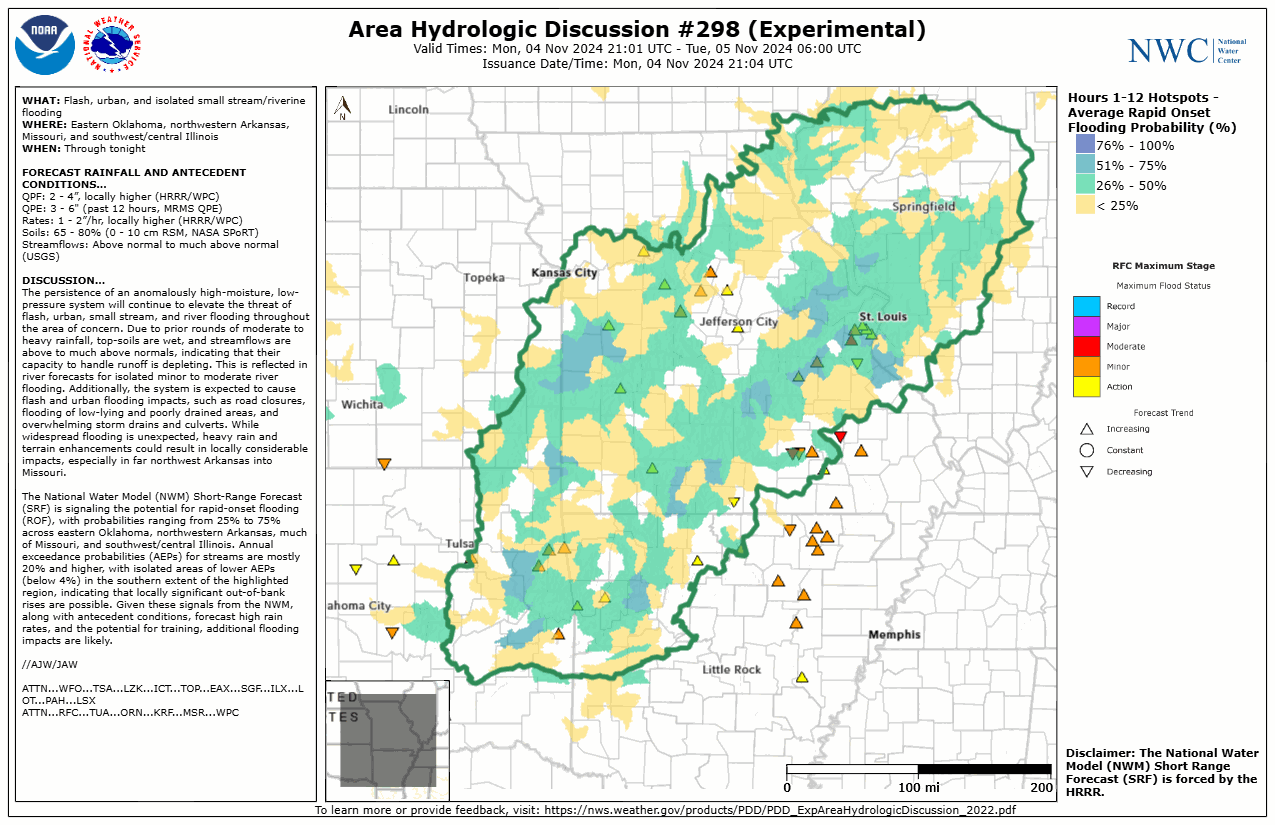

A Whole Lotta Rain
Earlier this month, myself and a couple of friends set out for a relaxing hiking trip along the Buffalo River in northwest Arkansas. For those that aren't familiar with the Buffalo River, it is a 135-mile river beginning in Arkansas's Boston mountains and runs east before ending as a tributary to the White River. While it can feature whitewater during high water, it is considered a fairly tame river, making it very popular for recreational kayaking and canoeing. But instead of the tranquil babbling of the normally docile river and tributary streams, we were greeted by the low rumble of a swollen river coming out of a moderate river flood that left a tangle of fallen trees and erased several sections of one of my favorite trails along the banks.

Truth be told up front: this isn’t the most impressive river flood I’ve ever seen (that distinction goes to the 2019 major flood along the Red River of the north in Grand Forks, ND), nor does this event even come close to the devastaing flooding across the southern Appalachians due to Hurricane Helene. However, this did provide an fun opportunity to inspect and document the damage of a river flood that normally gets overlooked.
Our hiking trip along the Buffalo began on November 6th, just one day after a 48-hour period of moderate to heavy rainfall that produced a swath of 10-12 inches of rainfall from Fort Smith, AR into southern Missouri. Harrison, AR reported the highest total with 12.35 inches during the November 3-5 period, though some QPE estimates suggest higher amounts may have fallen to the east/northeast of Fort Smith. The National Water Center highlighted the potential for stream and river flooding across the region in an Area Hydrologic Discussion on the afternoon of November 4th, by which point the Buffalo River had risen to Action stage and was quickly approaching Minor stage. A break in the rain temporarily early on November 5th abated the river rise temporarily before a second round of rain pushed the river into Moderate flood stage.


River Rise
While our hike was primarily focused to the east of Ponca, AR, a downstream river gauge at St. Joe, AR reported a peak rise of 35.52 ft - the highest the river has been since April 26, 2011 (35.53 ft). In fact, according to the NWS, this event was only the 20th time the Buffalo River at the St. Joe gauge has reached Moderate flood stage since 1915. This comes out to an average of one moderate flood event roughly every 5.5 years. So in some respects, this event was overdue. As mentioned, the last Moderate flood was thirteen years prior in 2011 (though the river did reach 34.47 ft on 4/30/2017, close enough, right?).

The Buffalo River in and around the Ponca, AR area is notable for its steep bluffs carved out by the river over the centuries. Even where there isn’t a sheer wall of rock the river valley is fairly steep, which confined the worst of the flooding damage to within 20-40 yards of the river (with the exception of a few shallow campgrounds along the river, such as the Steel Creek campground where we found evidence that the campground was thoroughly submerged). Once you reached the flood damage, however, forward progress along any trail became very difficult. Entire stands of trees along the banks were strewn about like scattered toothpicks, and mounds of displaced silt, mud, and rocks simply erased the old contours of the river while creating new ones. It was remarkable to so starkly see the results of such hydrogeological processes.

High Water Mark?
What was more remarkable were the subtle reminders of the river's full strength at moderate flood stage. The most visually impressive find was a fully grown V-shaped tree that was uprooted and wedged horizontally multiple feet above the ground onto an upright tree that managed to survive the flood. We had my friend Brett stand under the wedged tree for a quick picture to commemorate the remarkable find. Using (very) rough photogrammetry, I estimated that the tree was wedged between 14.5 ft to 15.5 ft above the ground.

However, this likely does not denote the high water mark for the local area. Our first impression was a high water mark of around 20 ft based on the light tree debris caught in the canopies of surviving trees. While hiking near the Highway 74 bridge that crosses the river we ran into two USGS employees surveying the damage. We asked them what they’d found so far, and they mentioned that there was evidence that the water had locally risen to 24 feet. They also made the curious comment that 24 feet was a new record. At the time we took them at their word, but upon finding the St. Joe observations, I wonder if they meant for the whole river, or just for this specific location? (Keep in mind that the St. Joe gauge is nearly 30 miles due east of the Ponca area.) The Highway 74 bridge has a river gauge painted onto one of the bridge piers, but it is only marked up to 17 ft. Using the image below, you can mentally add an additional 7ft to get a rough idea of how high the water was. Another subtle detail worth pointing out is the change in coloration on the trees in the background behind the bridge. This color change is attributed to tree bark erosion where the trees were submerged, and gives another rough indication of the high water mark.

Additional Notes...
At one point someone made a comment about how we hadn’t seen any dead fish or other aquatic creatures washed up along the shore. Our question was answered shortly thereafter when we found the desiccated remains of crawfish deposited 4 ft off the ground on an fallen tree - the handy work of scavengers. The flood held one more surprise for us as our hiking trip came to a close. While stopping at a local gas station we struck up a conversation with some of the locals asking about if they had any impacts from the flooding. They had. A water main break nearby prompted a boil order for much of the area, including the cabin we had been staying at… and had been drinking the water from…
For more information about this event, check out the event summary compiled by NWS Little Rock.

hidden text